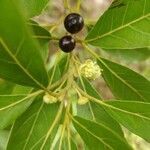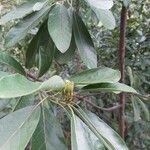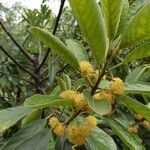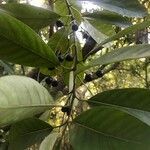Evergreen or deciduous trees, 3-15 m tall. Young branchlets gray-yellow tomentose. Leaves alternate; petiole 1-2.6 cm, gray-yellow tomentose; leaf blade obovate, obovate-oblong, or elliptic-lanceolate, 3.5-10(-26) × 1.5-11 cm, tomentose on both surfaces when young, tomentose or subglabrous abaxially and only midrib slightly tomentose adaxially when old, pinninerved, lateral veins 5-12 pairs, base cuneate, obtuse, or rotund, apex obtuse or rounded. Umbels solitary or several on short branchlets, few flowered; short branchlets 2-4 cm or more; peduncle 1-1.5 cm. Male flowers: pedicel tomentose; perianth segments imperfect or lacking; fertile stamens often 15 or more; filaments pubescent, of 3rd each with 2 long stipitate glands at base; rudimentary pistil glabrous. Fruit globose, 5-7 mm in diam.; fruiting pedicel 3-6 mm, slightly thickened at apex. Fl. May-Jun, fr. Sep-Oct.
A tall shrub or small tree. It grows 6-10 m high and 3-5 m across. The young growth is sticky. The leaves are 7-28 cm long by 3-18 cm wide. They are dark green above and paler with white hairs underneath. They are leathery and taper to the tip. The flower groups are 1-4 cm long. There are 6-14 flowers clustered in the axils of the leaves. The flowers are 0.4 cm across and cream or green. They have a scent. The fleshy fruit is 0.8-1 cm long by 0.8-1.1 cm wide. The are black.













